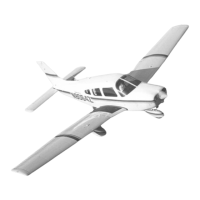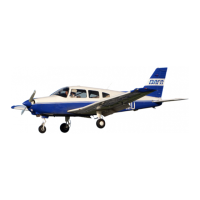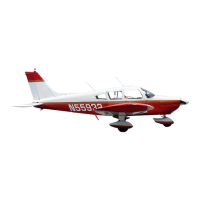PIPER AIRCRAFT CORPORATION SECTION 7
PA-28-161, WARRIOR II DESCRIPTION & OPERATION
ISSUED: AUGUST 13, 1982 REPORT: VB-1180
REVISED: MARCH 1, 2005 7-11
The annunciator panel includes alternator and low oil pressure indicator
lights. When the optional gyro system is installed, the annunciator panel also
includes a low vacuum indicator light. The annunciator panel lights are provided
only as a warning to the pilot that a system may not be operating properly, and
that he should check and monitor the applicable system gauge to determine
when or if any necessary action is required.
NOTE
When operating with light electrical load and a
fully charged battery, the Alternator Inop. light may
illuminate due to minimal alternator output. If the
alternator is functional a slight increase in electrical
load should extinguish the Inop. indication.
Optional electrical accessories include navigation lights, wing tip recognition
lights, anti-collision light, landing light, instrument lighting, and cabin dome light.
Circuits will handle the addition of communications and navigational equipment.
An optional light, mounted in the overhead panel, provides instrument and
cockpit lighting for night flying. The light is controlled by a rheostat switch
located adjacent to the light. A map light window in the lens is actuated by an
adjacent switch.
WARNING
Anti-collision lights should not be operating when
flying through cloud, fog or haze, since the reflected
light can produce spatial disorientation. Strobe lights
should not be used in close proximity to the ground
such as during taxiing, takeoff or landing.
Unlike previous generator systems, the ammeter as installed does not show
battery discharge; rather, it indicates the electrical load on the alternator in
amperes. With all the electrical equipment off and the master switch on, the
ammeter will indicate the charging rate of the battery. As each electrical unit is
switched on, the ammeter will indicate the total ampere draw of all the units
including the battery. For example, the average continuous load for night flight
with radios on is about 30 amperes. This 30 ampere value plus approximately 2
amperes for a fully charged battery will appear continuously under these flight
conditions. The amount of current shown on the ammeter will tell immediately if
the alternator system is operating normally, as the amount of current shown
should equal the total amperage drawn by the electrical equipment which is
operating.
For abnormal and/or emergency operation and procedures, see Section 3.
An optional wing tip/recognition light system consists of 2 lights (one in
each wing tip) and is operated by a split landing light/recognition light rocker
type switch mounted on the switch panel.
PIPER AIRCRAFT CORPORATION SECTION 7
PA-28-161, WARRIOR II DESCRIPTION & OPERATION
ISSUED: AUGUST 13, 1982 REPORT: VB-1180
REVISED: MARCH 1, 2005 7-11
The annunciator panel includes alternator and low oil pressure indicator
lights. When the optional gyro system is installed, the annunciator panel also
includes a low vacuum indicator light. The annunciator panel lights are provided
only as a warning to the pilot that a system may not be operating properly, and
that he should check and monitor the applicable system gauge to determine
when or if any necessary action is required.
NOTE
When operating with light electrical load and a
fully charged battery, the Alternator Inop. light may
illuminate due to minimal alternator output. If the
alternator is functional a slight increase in electrical
load should extinguish the Inop. indication.
Optional electrical accessories include navigation lights, wing tip recognition
lights, anti-collision light, landing light, instrument lighting, and cabin dome light.
Circuits will handle the addition of communications and navigational equipment.
An optional light, mounted in the overhead panel, provides instrument and
cockpit lighting for night flying. The light is controlled by a rheostat switch
located adjacent to the light. A map light window in the lens is actuated by an
adjacent switch.
WARNING
Anti-collision lights should not be operating when
flying through cloud, fog or haze, since the reflected
light can produce spatial disorientation. Strobe lights
should not be used in close proximity to the ground
such as during taxiing, takeoff or landing.
Unlike previous generator systems, the ammeter as installed does not show
battery discharge; rather, it indicates the electrical load on the alternator in
amperes. With all the electrical equipment off and the master switch on, the
ammeter will indicate the charging rate of the battery. As each electrical unit is
switched on, the ammeter will indicate the total ampere draw of all the units
including the battery. For example, the average continuous load for night flight
with radios on is about 30 amperes. This 30 ampere value plus approximately 2
amperes for a fully charged battery will appear continuously under these flight
conditions. The amount of current shown on the ammeter will tell immediately if
the alternator system is operating normally, as the amount of current shown
should equal the total amperage drawn by the electrical equipment which is
operating.
For abnormal and/or emergency operation and procedures, see Section 3.
An optional wing tip/recognition light system consists of 2 lights (one in
each wing tip) and is operated by a split landing light/recognition light rocker
type switch mounted on the switch panel.

